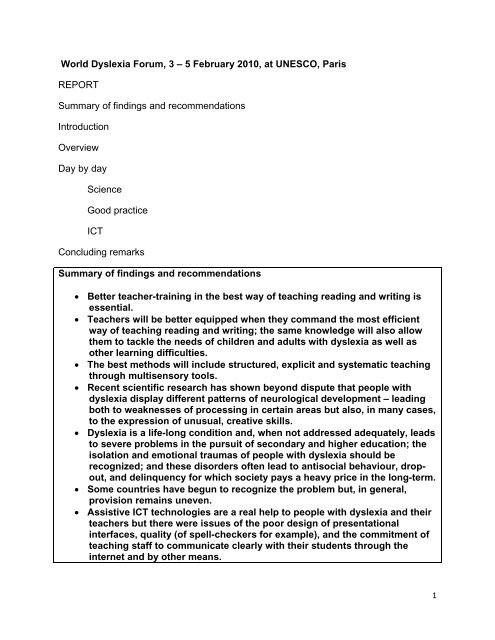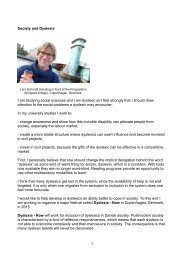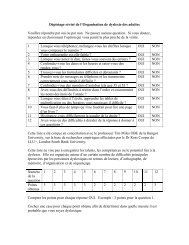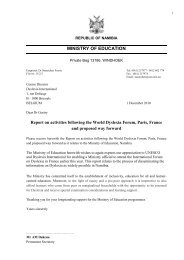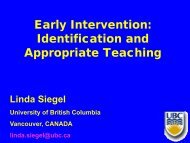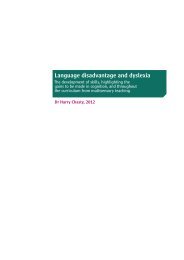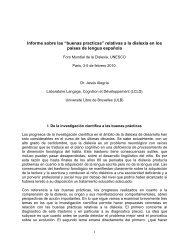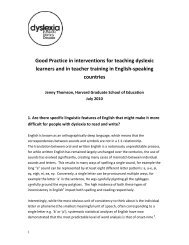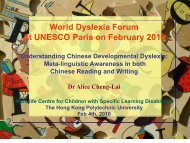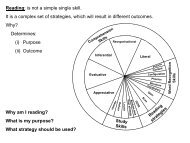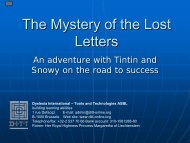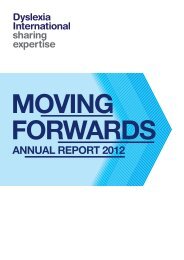World Dyslexia Forum, 3 â 5 February 2010, UNESCO, Paris
World Dyslexia Forum, 3 â 5 February 2010, UNESCO, Paris
World Dyslexia Forum, 3 â 5 February 2010, UNESCO, Paris
You also want an ePaper? Increase the reach of your titles
YUMPU automatically turns print PDFs into web optimized ePapers that Google loves.
<strong>World</strong> <strong>Dyslexia</strong> <strong>Forum</strong>, 3 – 5 <strong>February</strong> <strong>2010</strong>, at <strong>UNESCO</strong>, <strong>Paris</strong>REPORTSummary of findings and recommendationsIntroductionOverviewDay by dayScienceGood practiceICTConcluding remarksSummary of findings and recommendations• Better teacher-training in the best way of teaching reading and writing isessential.• Teachers will be better equipped when they command the most efficientway of teaching reading and writing; the same knowledge will also allowthem to tackle the needs of children and adults with dyslexia as well asother learning difficulties.• The best methods will include structured, explicit and systematic teachingthrough multisensory tools.• Recent scientific research has shown beyond dispute that people withdyslexia display different patterns of neurological development – leadingboth to weaknesses of processing in certain areas but also, in many cases,to the expression of unusual, creative skills.• <strong>Dyslexia</strong> is a life-long condition and, when not addressed adequately, leadsto severe problems in the pursuit of secondary and higher education; theisolation and emotional traumas of people with dyslexia should berecognized; and these disorders often lead to antisocial behaviour, dropout,and delinquency for which society pays a heavy price in the long-term.• Some countries have begun to recognize the problem but, in general,provision remains uneven.• Assistive ICT technologies are a real help to people with dyslexia and theirteachers but there were issues of the poor design of presentationalinterfaces, quality (of spell-checkers for example), and the commitment ofteaching staff to communicate clearly with their students through theinternet and by other means.1
IntroductionThe <strong>World</strong> <strong>Dyslexia</strong> <strong>Forum</strong> had been promoted to ministries of education expertsresponsible for teacher-training. Pre-<strong>Forum</strong> information had been sent to each ministryof education in over 190 countries. It attracted more than 250 delegates from 90countries. As well as ministries, local dyslexia support groups, agencies for specialneeds, researchers and people with dyslexia were well represented.The delegates were welcomed with a special mention of participants from the African,Caribbean and Pacific Group of States, sponsored by the European Commission.Mr Eden Adubra, Head of Teacher Training, was present on behalf of <strong>UNESCO</strong>.The Patron of the event was <strong>UNESCO</strong> Goodwill Ambassador Her Royal Highness TheGrand Duchess Maria Teresa of Luxembourg. In her opening remarks she placed welltrainedteachers at the centre of the response to <strong>UNESCO</strong>’s challenge for quality,inclusive education which was the right of all children. She commended the actions of<strong>Dyslexia</strong> International whose contribution was the development of online resources –technological responses that best met the needs for teacher training worldwide. Sheinvited delegates to play their part in promoting teacher training. Her Royal Highnessmade a heartfelt, personal plea for the recognition of the sufferings of children withdyslexia who felt worthless from the incapacity to learn.OverviewThe <strong>Forum</strong> was divided into three parts: scientific discoveries and trends in research;good teaching practice; and the use of ICT (Information and communicationstechnologies).Alongside the <strong>Forum</strong> there was an exhibition called Creativity beyond Words,celebrating the works of artists, designers and architects who had overcome theirlearning difficulties and made successful careers.Within the exhibition space six suppliers of educational resources for people withdyslexia had been invited to demonstrate equipment and materials that could directlybenefit children with learning difficulties and their teachers.The first evening was rounded off with a screening of The Indian film Taare Zameen Par/Little Stars on Earth. Through the story of one child this film had had an unprecedentedimpact in awareness raising. Viewers were left in no doubt about the devastating effectsof dyslexia at personal and social level. The film was introduced by the creativedirectors Amole Gupta and Deepa Bhatia, flanked by the President of the Maharashtra<strong>Dyslexia</strong> Association, Kate Currawalla.2
On the second evening a major sponsor of the <strong>Forum</strong>, Olympus, presented a prototypeof an audio device designed to help people with dyslexia and promote organizationalskills.ScienceThe first day of the <strong>Forum</strong> was dedicated to discoveries within the last 20 years.Dr Duncan Milne from the UK talked about ‘teaching the brain to read’. Speaking as aneuro-linguist, he provided an explanation of the reading circuits in the brain and howthey had to be connected together to provide the mechanisms for fast, accuratereading. In brief, two circuits could be characterized. One was a ‘decoding’ pathway fornew words, which was heavily exploited in early stages of reading acquisition. Propertraining of this pathway led to the development of the faster circuit, an automatic systemof ‘direct access’; the visual shapes of letters and groups of letters were then linked tothe part of the brain used for pronunciation and listening. It was essential to discoverwhat might be going wrong in one or both of the systems in order to bring the mostsuitable kind of help to the learner.Dr Franck Ramus from France works as a CNRS research scientist at the EcoleNormale Supérieure, where he studies language acquisition and its disorders (dyslexia,specific language impairment, autism). He had participated in the INSERM 2007 expertreport on <strong>Dyslexia</strong>, dysorthography, dyscalculia. His talk concentrated on the‘phonological deficit’ of people with dyslexia but also mentioned weaknesses in rapidnaming and short-term memory. By ‘phonological deficit’ is meant the weaker ability inpeople with this condition to grasp that an alphabetic language (like French or English)consists of streams of abstract smaller units, syllables, which in turn consisted of evensmaller units called phonemes. This deficit, it is widely agreed, accounts for about 80 %of people presenting with dyslexia but the underlying cause of the condition was not yetevident. Dr Ramus reviewed the various theories for a causal explanation of thephenomenon.The Chairman of <strong>Dyslexia</strong> International’s Scientific Advisory Committee, Professor JohnStein, a neuro-physiologist at Oxford University, UK, offered a neurological theory forthe cause of the deficit. This premised the theory of the abnormal development of one ofthe principal visual optical tracts, the magnocellular nerves. These carried informationabout fast changes in the periphery of the visual field (as opposed to the parvocellswhich dealt with fine discrimination) but which were also responsible for the control ofthe fine-tuned tracking of the eyes across a line of print. About ten genes had beendiscovered so far that were implicated in the incorrect migration of these nerve cells tothe normal destinations to make orderly connections with their targets, and, like allgenes, these were subject to errors of function. But there were comparatively3
inexpensive ways to help such people, which included using coloured filters in front ofthe eyes and promoting a diet which contained certain fatty acids.Dr Maria Luisa Lorusso from Italy talked about ‘hemispheric specialisation and dyslexia’.Her and others’ work stemmed from principles developed first by Professor Dirk Bakkerin the Netherlands (a former chair of <strong>Dyslexia</strong> International’s Scientific AdvisoryCommittee). The core of this ‘balance model’, as it is called, is that in normal readersthere is a shift from right hemisphere activation to left hemisphere activation during thecourse of learning to read. Dr Lorusso showed the evidence from numerous scientificstudies she and other researchers had supervised. Where this shift was not madeproperly she and co-workers distinguished three subtypes of dyslexia: ‘L’-types (whoread faster but less accurately); ‘P’-types (more accurate but slower); and ‘M’-types,showing mixed characteristics. The P-type children failed to shift from the right to the lefthemisphere and kept relying on the decoding path; the L-types shifted too early(meaning that the systematic grapheme-phoneme conversions were not properly learnt)and so they relied, with less accuracy, on linguistic clues; and the M-types were unableto activate either strategy. Following proper diagnosis, she recommended training moreactivation in the less involved hemisphere with choices of suitable computer softwareand other training materials.At the end of the first day Professor Angela Fawcett of the University of Swansea, UK,chaired a panel discussion. She introduced herself as a researcher in psychology and amother of children with dyslexia. Her own point of view was that people with dyslexiahad problems which went well beyond difficulties with reading and writing. The basic allpervadingcharacteristic was less than optimal processing.The main topics discussed are summarised below.OrthographyLanguages like English and French have what is called a ‘deep’ (difficult) orthography incomparison to Spanish and Italian which have a regular orthography. One question wasput whether there was a long-term cognitive benefit to learning a language with a deeporthography. The consensus from the panel was in the negative. There was no realadvantage and, on the contrary, English for example imposed a heavy load in the earlystages of reading acquisition; readers in the more regular languages made much morerapid progress. Furthermore, English was the dominant choice as a second foreignlanguage; dyslexia could well be masked in a child until he or she had to learn English.Professor Fawcett was cautious about cross-linguistic studies which might not besensitive enough nor measured exactly the same thing so that, for example, and insupport of Dr Lorusso, Italian children with dyslexia did score less well when accuracywas properly assessed.4
BilinguilismConcerning bilingualism, a precision was needed: there was a difference betweenbilingual children brought up by parents with different languages and those children whoacquired a fluent second language. (Brain scans showed that the elements of a secondlanguage learnt after the age of about eight were found in a slightly different area of thebrain to the first.) In general, there was no evidence that children with dyslexia had moredifficulty in acquiring spoken skills in a second language but they often had moreproblems with reading and writing.The cerebellumThere was a question about the role of the cerebellum (the ‘little brain’ low in the back ofthe head). Some controversy surrounded the causal role of the cerebellum in dyslexia.What was not in doubt was the function of the cerebellum in coordinating automaticmovement, which included the fine-tuned skills of speaking. The cerebellum was linkedto Broca’s area which is the part of the brain concerned with speech production. Thereported under-activity of the cerebellum in people with dyslexia could be one reasonwhy the phonemes were finally represented ‘fuzzily’, which could stem from less precisegrapheme-phoneme conversions. Finally, the cerebellum was implicated in theconversion of sensory information to motor commands (e.g. speaking).Differing views of scientistsThere was a discussion around the different views expressed by the four scientistsduring the day and whether or not a slightly contentious, confused picture could havebeen presented to the delegates. The panelists rejected this. There were indeeddiffering views about the fine details of the science, the interpretation of data, andespecially in deriving cause from correlation. But everybody agreed that there was afundamental phonological deficit in most people with dyslexia. Far more important – andnot in dispute – was the identification of children at risk as soon as possible, and theimmediate provision of the best possible remedial measures.MemoryThere was a question about what research was being done about memory, especiallyshort-term memory as this deficit was so frequently mentioned in relation to dyslexia.The answer was that research was going on but not enough. Professor Fawcett saidthat it was important that even competent, compensating adults should grasp theprinciples of what they were being taught (rather than relying on ‘scaffolding’ aids tolearning) and this could be achieved only by explicit teaching. Students with dyslexia5
found it hard to retain what they had learnt. Professor Stein remarked that he made nodifference between memory, sensory processing and the coordination of movement, forwhich he had offered a causal explanation, and that the entrainment of good sleeppatterns certainly improved memory. Dr Milne recommended analytic phonics (that isbreaking down words rather than building them up) as more suitable for people withpoor memory. Dr Lorusso had found no difference in the memory capabilities in the subtypesshe had characterised but significant differences between dyslexics and nondyslexics.It was essential to inhibit distracting input but huge improvements could bemade by training with presentation of material to the appropriate hemisphere.AttentionThe previous question led to a consideration of attention in general. Some confusionarose when failure to deliver work on time was attributed to lack of attention – moreoften it was the case that the pupil simply could not do the work. Professor Steindistinguished ‘attention’ from ‘vigilance’ which was the ability to survive distraction; hepointed out that vigilance could be improved with better sleep. Focal attention dependedunequivocally on the magnocellular system and his group had shown improved ability tofocus attention with a diet which included fish oils.CreativityA question about creativity and whether or not it was found more often in people withdyslexia led a wide-ranging discussion. The panel did agree that exceptional abilities,especially in areas of three-dimensional visualisation, colour appreciation, mathematics,and more generally holistic thinking, were often evinced in people with dyslexia. But itwas also said that creativity as such was difficult to measure and hence robustconclusions were not yet available. Dr Milne had found no difference in scans ofcontrols and gifted subjects but noted that it was impossible to have a creative personwithin a machine at the moment of the creative spark. Dr Lorruso had found visualabilities in P-types and linguistic abilities in L-types. It was also possible that people withdyslexia avoided stereotypic responses and were therefore good at imaginative tasks.From the practical point of view it was vital to find a niche for the dyslexia learner so thathe or she could cultivate their interest (or ‘obsession’) in no matter what area.Legal provisionThe last point of discussion related to legal provision for children with dyslexia. DrRamus remarked that it was a good thing in the UK and USA, where there were rightsfor people with dyslexia, but for the rest of the world it seemed like ‘science fiction’.There was however, in the UK anyway, an unintended consequence whereby themiddle classes who could afford diagnoses had more than a fair share of resourcesdirected towards their children and so the have-nots had even less.6
Professor Fawcett rounded up by repeating that early diagnosis and remediation wasessential and that the cost of early intervention was far less than the heavy financialburden of retrieving the situation later.Good practiceProfessor Linda Siegel presented the results of a study in North Vancouver, Canada,after beginning with a striking observation from other states: 82 % of street youth inToronto had undetected and unremediated learning difficulties; all the adolescentsuicides in Ontario also had the same difficulties; and 75 – 95 % of the prison,population had significant reading problems. The aims of the study were to identify andhelp children at risk and then evaluate the results. The children in the study improvedsignificantly after good reading instruction in which they were taught phonologicalawareness, letter-sound relations, vocabulary and syntactic skills. The bilingual – oreven multilingual – situation of Canada was no barrier; after skilled instruction many ofthose working in their second language, dyslexic or otherwise, had better reading andrelated skills than their monolingual peers.Professor Porpodas from the University of Patras, Greece, then introduced the sixspeakers from different language regions. The study was based on a questionnairewhich <strong>Dyslexia</strong> International had disseminated widely in the two years leading up to the<strong>Forum</strong> in order to collect information and provide a common structure.ArabicDr Sana Tibi from the United Arab Emirates University presented her findings from theArab States, based on replies from eight countries. Although literacy was encouragedthe literacy rate was not adequate and displayed great variance between countries.Arabic orthography was seen as a constraint. Morphology was a key factor becausethe language depended critically on the shape of the writing. Recitation from the Quranrelied on memory skills rather than a deep understanding of phonological principles andso instruction was more often in reading and not in learning to read. Colloquial Arabicwas often the language of the classroom and she was concerned that in manyclassrooms she had visited the teacher was not proficient in classical Arabic. <strong>Dyslexia</strong>was not recognized and there was a notable lack of standardized assessment tools andmethodologies. Professional development was poor.ChineseProfessor Alice Cheng-Lai from the Hong Kong Polytechnic University said that learningto read Chinese required rather different insights from young readers than did analphabetic system. Chinese readers with dyslexia could be distinguished from agematchedcontrols with tasks of morphological awareness, speeded number naming, and7
vocabulary skill whereas performance on tasks of visual skills or phonologicalawareness failed to distinguish the group. Research showed that morphologicalawareness might be a core theoretical construct necessary for explaining variability inreading Chinese. Morphological instruction aided mastery of the structural rules ofdifferent types of characters followed by application of the rules used analytically whenlearning to read and write. Children could make use of such strategies when they hadcorrectly learnt the morphological rules of Chinese orthography.EnglishProfessor Jenny Thomson from the Harvard Graduate School of Education, USA,reported on the feedback from the USA, Europe, parts of Africa, and South-East Asia.Literacy was encouraged and seen as essential for the development of knowledge andsociety. Where access was equal girls outperformed boys. Where funding wasadequate it had to be decided if it was better allocated to raising the population mean orto improving those below and above the mean. There were laws against discriminationin the USA and UK but criteria of eligibility had to be agreed; research showed thatliteracy ability was a continuum which then posed the problem of whether one shouldestablish a discrete cut-off point to intervene or wait for the child to fail. In terms ofremediation, good practice depended on developing phonological awareness - bothsupported and independent reading of progressively harder texts - as well as thedevelopment of comprehension strategies for reading. In terms of process, teachingshould be phonetics-based, multisensory, cumulative and sequential. Training shouldaim at automatisation of skills through continuous practice in small, ‘scaffolded’ steps.Professor Thomson reviewed some important references and concluded her report withan affirmation of the key role of the teacher in providing motivation, self-confidence, andachievable, monitored goals.FrenchProfessor José Morais from the Free University of Brussels, Belgium, started with thepremise that ‘at the behavioral level dyslexia was the selective impairment of the abilityto identify the written word’. The cognitive level of description was the one that couldinspire the best method of detecting and helping children with dyslexia. Not all poorreaders were dyslexic. Conditions for learning to read in the alphabetic system of writingwere the discovery of the alphabetic principle, the progressive mastery of theorthographic code of the language, and the constitution of an orthographic lexicon.Phonemic awareness was the strongest contribution to the reading of words. Amongstthe recommendations for action were: more research to compare training programs; thepreparation of teachers according to recent scientific advances; determination of thereader’s profile in order to intervene specifically on impaired abilities; targeting of8
phonological abilities and/or visual processing; and compensatory tools (for example,voice recognition).RussianProfessor Elena Grigorenko from Yale University, USA, and the Moscow StateUniversity, Russian Federation, characterized this language as relatively regular, highlyphonemic but morphologically complex in the way, for example, the visual pattern forplurals was displayed. It also had a complex syllabic structure and readingcomprehension was not aided by word order but by inflectional differences. People withdyslexia showed a low speed of reading, and lack of accuracy and comprehension.There were laws about the treatment of children with physical and mental problems andthere were supporting staff like logopeds and psychologists. However no law citeddyslexia. Accommodation could be made by the classroom teacher in respect of notbeing required to read aloud and being given more time with assignments, but personalcomputers or voice recorders were not permitted ‘nor even considered’. The fact thateven the existing (unsatisfactory) legislation was not always respected had beenacknowledged by officials. In spite of a rich tradition of Russian literature and, ingeneral, support for and the acquirement of a good level of literacy, as well as manyexamples of good practice and excellent materials, there remained a lot to do.SpanishProfessor Jesus Alegria from the Free University of Brussels, Belgium, addressed goodpractice in the Spanish language. The language had a regular orthography, a clearsyllabic structure and a limited number of vowels to handle. There were relatively fewproblems in decoding but a lower performance in speed and fluency of reading wasmanifest in children with dyslexia. Rapid naming tasks and the timing of reading wordsand pseudo-words provided useful indications of these deficits. Recent scientificknowledge should overthrow misconceptions about dyslexia and dictate good practicein the training of teachers as well as buttressing the support networks of parents,experts in remediation and local associations. Optimal intervention called for early helpwith systematic and explicit phonetic methods. Specific legislation was comparativelyrecent. In Spain there was a law which cited the needs of children with dyslexia, leavingpractical implementation to local authorities but there appeared to be a lack ofresources to carry out these provisions adequately. Chile and Uruguay had similarlegislation. The principal requirement was to improve the training of teachers, especiallyfor the pre-school and primary school ages.Re-balancing Anglo-centric researchThe main concern of Professor Heinz Wimmer of the University of Salzburg, Austria,was that a lot of research into dyslexia had been performed on English-speakingsubjects and the extreme irregularity of that language distorted the picture. He criticised9
the pervasive model of dyslexia which promoted the theory of a phonological deficit andwhich was based on the concept of the phoneme, which in his view was unnatural.Careful examination of cross-linguistic tests in speed and accuracy of reading showedthat English was a notable outlier and he maintained that it was chiefly owing to theorthography of the language. It was not a question of deficient phonological analysis butof the speed of conversion from vision to phonology, and this view was supported by thesame profile shown in a specific case of acquired dyslexia (that is from an accident ordisease). This skill was difficult to acquire as it was very resistant to training. In broadterms, he suggested the problem lay further back in the brain (towards the occipitalcortex dealing with vision) and the speed of connection forward to the area forphonology. Other evidence in support was the dwell-time on groups of letters whenmeasured by eye movement. In short, he approved of the definition of the Dutch HealthCouncil which stressed the automaticity of word identification that meant in turn theestablishment of a good orthographic lexicon.Education reform in FinlandMadame Claude Anttila presented the results of a radical change in the educationsystem. Confronted by unequal success rates in schools, Finland had reformed itssystem in 1970 to give all children a good education in order to prepare them for highereducation. At the same time it upgraded the professional standing of teachers byimproving the quality of their training. Those initiatives to bring more specializedknowledge to teachers were taken in order to enhance the prospects of young people.At the beginning of 1980s nobody had been told about dyslexia. In fact its frequencywas high in Finnish even though it had a regular orthography (but with subtle aspectssuch as the completely different meaning conveyed by doubled consonants).Knowledge of dyslexia had been improved after better awareness amongst teachers ofchildren with learning difficulties. The teacher had to instruct each child in his or herclass according to the child’s needs, using different techniques which also helped allchildren. That required a lot of preparation and know-how. The Finnish system did notmake children repeat their year. It integrated children of different social classes with orwithout learning difficulties and encouraged each child in the school to take an activepart in life. The reforms had contributed to an outstanding system of education attestedby numerous international measures.Round-up and complementary remarksDr Harry Chasty, an international consultant, briefly summarised the presentationsmade earlier before identifying what he saw as the two major impediments toimprovements in the teaching of reading. One was cost and the second was agreementabout the best methodology to use.10
With regard to cost, desirable results did not seem to lead conclusively toimprovements in literacy. To take just one country, the United Kingdom. That countryhad doubled its spending on education within the past eight years but performance hadactually declined. 40 % of pupils were leaving primary school without a basic groundingin reading, writing and arithmetic and 25 % lacked reading skills to benefit fromsecondary education. The UK was not unique; in fact the relationship between spendingper student and learning outcome in most countries was weak.Current research indicated that it was better to target more funds at under-achievers injunior and middle grades.The principles adopted by the <strong>Forum</strong> planning group were in accordance with recentlypublished findings by the UK House of Commons Science and Technology Committee,that dyslexic learners were no different from other failing readers and recommended theteaching of synthetic phonics. He had no quarrel with that conclusion in the narrowcontext of learning to read but had serious reservations about its application to themuch wider context of the student’s representational and learning skills. <strong>Dyslexia</strong> wasnot simply about reading, spelling or writing. The dyslexic learner had problems withorganization, processing, motor skills and working memory. <strong>Dyslexia</strong> necessitated adifferent approach whereby competencies were stretched so that the pupil learned howto learn.Structured multi-sensory teaching methods addressed the complexity of the cognitiveskills required for comprehension. Reading entailed the ability to extract meaning fromvisual representation, in whatever sequential order the language required, possibly tobe able to express the ideas aloud in words, store them in memory for later evaluation,recall and further use. That was a complex process. Building on the appreciation ofphonological structure implicitly conveyed by parents and pre-school teachers, the pupilhad then to link shape of letter to sound by using many modalities: sound, sight, andmovement of the muscles using in speech and writing. The establishment of such crossmodallinks was difficult for the child with dyslexia; ‘look and say’ methods and simplephonics were not adequate.Teachers also had to know the importance of structure and building skills sequentially,making sure that each block was firmly in place before proceeding to the next stage.The student had to be aware of recognition skills, reading strategies, and study andcomprehension skills.Structured multisensory training stimulating the development of manifold skills hadgained wide authoritative acceptance and were an essential economic investment.Dr Chasty related a study made of reading amongst Harvard graduates in 1959. Manyseemed to use only one strategy for reading which made them vulnerable when11
confronted by the sudden huge increase in reading material. Instead, they had toacquire metacognitive skills, understanding their own individual most effective andefficient way of learning. Instructors had to impart that knowledge explicitly if their pupilswere to succeed in both college and work.Information and communications technologiesUsing digital technologies to support special education needsProfessor Diana Laurillard presented the developing new discipline of ‘educationalneuroscience’, which aimed to find common ground in the research methodologies ofneuroscience, cognitive psychology, and education in order to inform both pedagogicpractice and further research. Her experience was with dyscalculia – difficulty withnumbers – but she derived broad lessons from the methodology that applied equally toresources for teaching people with dyslexia. Good teachers set up the following kinds ofrecommended practice: the goals were made meaningful to the learner; the learner wasallowed to achieve the goal the result of which was fed back; and the learner wasthereby motivated to revise in order to improve. The advantages could be summarisedas, for learners: opportunity for unsupervised repeated practice; easier manipulationthan physical objects; and virtual environments linking the physical to the abstract. Forteachers: the capture of pedagogic principles for revision; customisation of tasks by theteacher; and the sharing of effective pedagogic practice.Online learning courseDr Vincent Goetry introduced <strong>Dyslexia</strong> International’s free online course, in English andFrench versions, of which he was the principal author. He explained the sponsorship,genesis, evolution and evaluation of the course.The course was based on scientifically-grounded principles recommended in recent,influential reports from Belgium, France, the UK and USA and also promoted<strong>UNESCO</strong>’s policy of inclusion.The course had video clips, testimonies, animations and interactive question andanswer sessions.For more information please click here.http://www.dyslexia-international.org/OnLearning.htmFilmDr Goetry then introduced <strong>Dyslexia</strong> International’s new film, in French, « La dyslexie –Comment tresser une structure d’accompagnement solide ? » (<strong>Dyslexia</strong> – How to12


